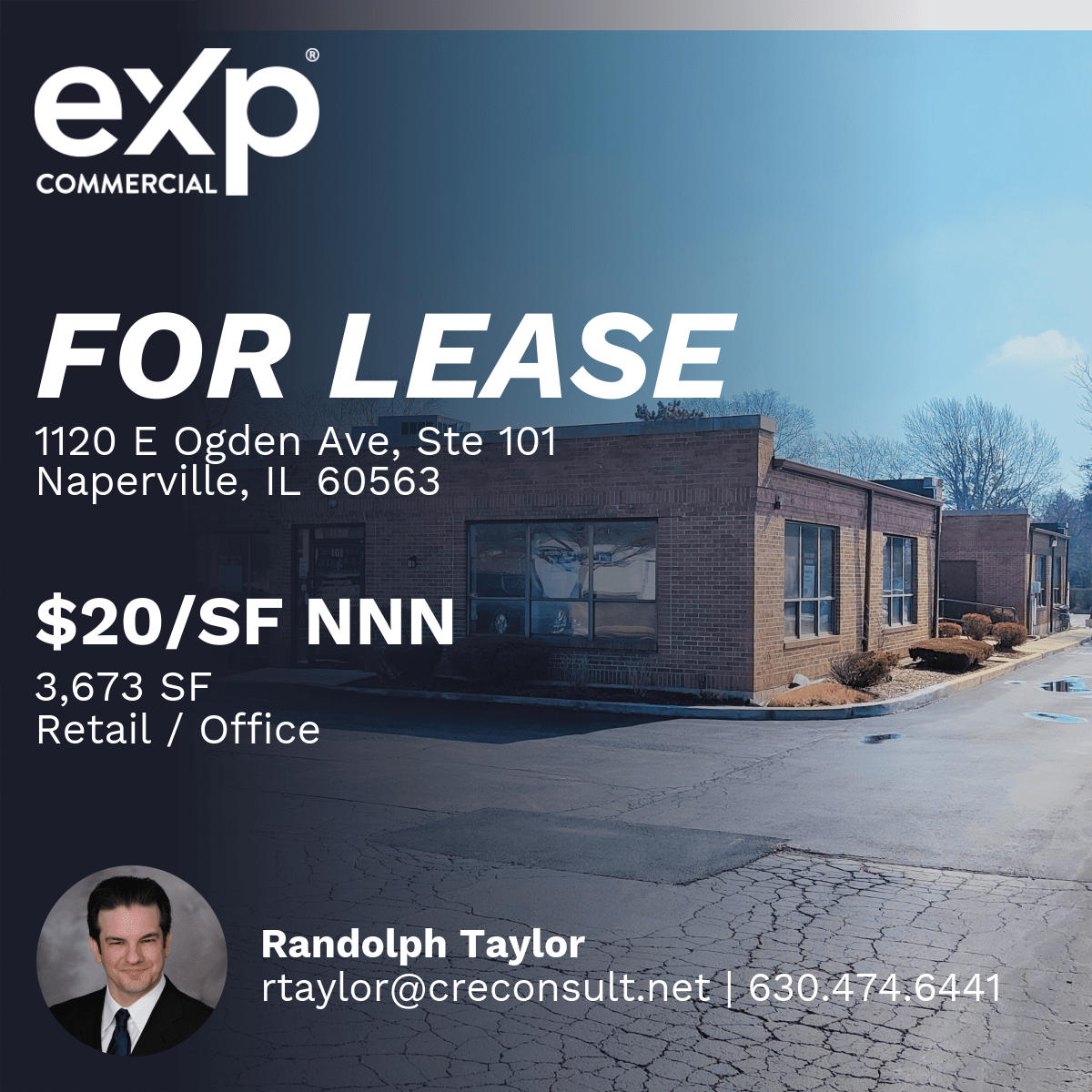$425,000 | Heavy Value-Add | 20.5% Cap Rate (Proforma)
631 E Lincolnway | Morrison, IL 61270
https://www.creconsult.net/for-sale-heavy-value-add-23-unit-multifamily-property-morrison-il/

eXp Commercial is one of the fastest-growing national commercial real estate brokerage firms. The Chicago Multifamily Brokerage Division focuses on listing and selling multifamily properties throughout the Chicago Area and Suburbs.


Real estate in 2021/2022 was as competitive as it's ever been. As a result, multifamily properties were in demand as investors looked for stable assets to park their cash. Unfortunately, it was hard to compete with yield-motivated investors. Many multifamily homes for sale were scooped up for depreciation, 1031 exchanges, or to add more units to an existing portfolio.
Competing with investors with the aforementioned ulterior motives will be challenging to overcome if you are primarily concerned about returns metrics such as IRR, equity multiple, or cash-on-cash return. They typically can justify paying more. You'll need to brainstorm ways to find projects that aren't as highly coveted and won't garner as much attention on a brokered listing.
The term "value-add" has been ad nauseam for the last few years. Every apartment that ever hits the market can be construed as a value-add one way or another. Investors eat up the idea of value-add, and brokers know this. As a result, new listings marketed as "value-add" will be the most competitive listing there. You will likely be one of the dozens of bidders, and to win the deal, you will have to beat everyone else. Unfortunately, this isn't an excellent formula for consistently finding reasonably priced buildings.
Any pure multifamily project (meaning it only consists of apartment units) will be challenging to be competitive when a broker is listing it. So, what exactly should you be looking for if you want to reduce competition and find a project that can kick out some yield?
When I started working in multifamily real estate as an analyst on the sell side, there were always characteristics of buildings that made them less desirable. Going into a sale effort, the team would know buyer interest would be muted compared to the properties that didn't have these traits or "hair." Since starting Tactica and helping investors on the buy-side, I've seen many of the gritty veterans I work with will only target "messy" deals listed by brokers to eliminate a good chunk of the competition.
Generally, investors hate going out of their comfort zone. Often, the investment committee, the ultimate decision-maker behind an offer, will stubbornly stick to their investment criteria. Any project facet that doesn't check the boxes is an automatic disqualifier.
My advice to investors struggling to be competitive in this environment is to get comfortable in the "less desirable" niches of multifamily investment. Spend time studying the nuances of hairy projects and gain comfort with them.
Multifamily investors tend to hate commercial components. Ground-level retail is a pain to underwrite and is inherently more risky than the multifamily component. The more significant the commercial income portion of total revenue, the more skittish other investors will be. The property won't qualify for traditional multifamily agency financing if commercial income is more than 20% of total revenue. This obstacle is a massive disqualifier for many investment shops.
Furthermore, commercial lease language is confusing and wordy. You'll be reading hundreds of pages of legal jargon if you have to review a handful of commercial leases. You also must understand how common area expenses (CAM), insurance, property management, and property taxes are allocated and rebilled between the apartments and commercial components. Understanding how the commercial functions in the overall project can be challenging, especially when less sophisticated owners fail to track it well.
Unlike a multifamily lease, where if the tenant fails, you can quickly remarket the unit and get it backfilled, retail leases involve hefty leasing commissions, tenant improvements budgets, and long vacancy lags before the unit produces cash flow again.
Finally, we are coming out of a pandemic that affected retail and office much more than other commercial asset classes. There are still many questions about the viability of these asset classes long-term. This could be an opportunity for the contrarian investor.
Understanding all the nuances of low-income-housing-tax-credit (LIHTC) properties or project-based Section 8 can require a steep learning curve. In addition, there's strict compliance and a ton of administrative oversight to operate an affordable property. As a result, few real estate professionals practice solely in this space. Investors with this knowledge have a massive advantage as the barrier of entry into this space can be daunting and expensive.
I see a ton of opportunity in the hybrid market/affordable (perhaps 30% of the units are set aside as affordable, for example). Many projects developed in the 2000s required allocating a certain percentage of the unit mix as "affordable" to gain approvals. Any affordability requirements can be a "non-starter" for bidders. The investors willing to work to understand the oversight and compliance requirements can access a wide array of projects that other investors won't be comfortable with.
There is also a massive advantage to looking at a market rate listing that you could potentially convert to affordable housing. If you can figure out how to piece together various affordability programs, it may allow you to be more competitive than "market rate" buyers. Anytime converting from market rate to affordable, the due diligence period will inevitably take longer. You'd need a seller willing to wait a more extended DD period.
The carrot enticing them to do this is likely more money and more aggressive earnest money. Your benefit would be buying a property with limited equity (potentially no equity), the opportunity for a development fee on the renovations, and ownership in a severely underserved and undersupplied sector.
Real estate investments in a tertiary or "outstate" submarket offer many benefits. I discuss seven encouraging trends I discovered when analyzing properties outside major metro areas.
Many investors will not venture outside the big cities or surrounding suburbs. However, if you are willing to venture into cities that aren't dependent on the major markets for employment, you are guaranteed to field less competition when bidding. Plus, many more prominent property owners won't have their economies of scale built up in the more sparsely populated submarkets.
Investors hate assuming debt because of the decreasing interest-rate environment of the last decade. Assuming debt traditionally has meant two things:
If you are a well-capitalized operator willing to assume financing, you will have fewer fellow bidders than chasing a "free and clear" offering. Many sponsors need to obtain new debt as they only have enough equity commitments for 20% - 25% of the purchase price. Assuming debt will mean you'll likely need more equity to 30% - 35% of the purchase price. Investment yields may be muted compared to a fully leveraged purchase, which will also be an eliminating factor for various investment committees.
These loans will eliminate potential buyers if the debt is HUD, bonds, or something more "exotic" than agency financing.
Property taxes are commonly the most significant operating expense for an apartment building. Frequently there are murky property tax incentives that are hard to ascertain value. For example, a property built five years ago was granted a property tax incentive from the city for twenty years. Property taxes are steeply discounted right now, but the benefit will run out in 15 years.
How do you value this benefit? For example, if you purchase this property, you'd benefit from the property tax reduction, but when you sell it one day, the next buyer would not. Can you cap the NOI that includes this discount if the benefit won't be there forever? Will your competition be capping it? How will the next buyer approach it?
If you can get comfortable underwriting the "gray areas" of multifamily, you're at an advantage. Many groups will have already "punted" the opportunity because they don't understand the nuances and prefer to look for a "cleaner" offering.
Tax increment financing (TIF) is another typical incentive sellers will include in multifamily offerings. Many investors aren't comfortable underwriting TIF and will pass on the opportunity immediately. If you can get smart on TIF, specifically valuing its worth, you will be at a distinct advantage as many capable "would-be" buyers will opt out.
You are not alone if you are frustrated by the amount of competition you face on a brokered apartment listing. Perhaps it's time to switch up your strategy and focus on the properties with less desirable elements to the greater investment community. They say life starts at the end of your comfort zone. This sentiment couldn't be more accurate in the current multifamily investment environment.
Source: How to Find Multifamily Listings With Less Competition
https://www.creconsult.net/market-trends/how-to-find-multifamily-listings-with-less-competition/
WASHINGTON (May 9, 2023) – National Association of Realtors® Chief Economist Lawrence Yun presented an overview of U.S. commercial real estate Tuesday as part of the 2023 REALTORS® Legislative Meetings. Yun emphasized challenges facing the commercial real estate market brought on by tightening lending policies among many small and regional banks, which have been a key source of commercial loans. Still, due to continuing U.S. job gains, net absorption has been mostly positive nationwide, Yun said, with the apartment, industrial and retail sectors helping to keep the industry relatively stable.
"The performance of commercial real estate markets will vary across the country," Yun projected during Tuesday's Commercial Economic Issues and Trends Forum. "Markets with strong job gains will naturally hold on much better, while those with weaker job conditions will struggle to raise net occupancy."
Yun said America's apartment sector recorded 116,000 net positive absorptions in the past year, while the industrial and retail sectors added 361 million square feet and 64 million square feet, respectively, over the last 12 months. Office markets, however, saw a reduction in net absorption by 29 million square feet over the same period.
"The national office market will continue to see rises in vacancy rates due to falling demand," Yun added. "The apartment sector will record a modest uptick in vacancy due to robust new supply."
With the impact of mortgage interest rates on the housing market in focus throughout the week at NAR's conference in D.C., Yun addressed the implications of Fed decisions on nationwide commercial markets.
"The Federal Reserve's aggressive rate hikes have damaged balance sheets for regional and local banks, an important source of commercial real estate loans," he said.
Yun estimated that continual rises in rates will in part cause commercial real estate transaction volume to decline by 27% overall in 2023.
"The lack of capital, higher costs of financing and refinancing, and the weakening economy will contribute to a lower overall valuation of commercial real estate prices," Yun said. "Weaker prices will mean opportunities for those with deeper pockets to get deals done in the months and years ahead."
Yun added that appraisal values have fallen by an average of 15% from peaks in early 2022.
Source: NAR Chief Economist Offers Commercial Real Estate Market Forecast
https://www.creconsult.net/market-trends/nar-chief-economist-offers-commercial-real-estate-market-forecast/
Debt yield hasn’t traditionally been a primary commercial real estate loan underwriting metric, but more lenders are incorporating it into their criteria. In the current real estate market, measuring debt yield ratios provides lenders with a stable assessment regardless of unusual or changing conditions.
Debt yield is a standardized way to measure net operating income (NOI) against total loan value. The ratio is simple to calculate, but it’s an accurate measure of risk that can be used to evaluate individual loans or compare different loans.
The math required for a debt yield calculation is simple and easy. The debt yield formula is:
Debt Yield = Net Operating Income / Loan Amount
For example, consider the purchase of a property with $300,000 NOI and a loan of $3 million. In this example, the debt yield is 10 percent ($300,000 / $3,000,000 = 10%).
Answer a few questions and get custom mortgage quotes. We'll match you with offers from our network of 650+ lenders.
Lenders use debt yield ratios to determine what their return would be if a buyer immediately defaulted on a commercial real estate loan. Loans with low debt yields are considered riskier, as the lender would receive a smaller return in the event of foreclosure. Higher debt yields are less risky because the lender would receive a larger return and could recoup their losses faster.
Once lenders know what annual return they’d receive, they can calculate how long it’d take to recoup the loss on a foreclosed property. This is done by dividing 100 percent by the debt yield ratio (annual return). The result is the number of years that it’d take to recoup all losses.
Recoup Time = 100 / Debt Yield
Assuming the above debt yield of 12 percent, the lender could recoup their investment in around 8.3 years (100% / 12% = 8.33 years).
Borrowers can alternatively use the ratio to calculate the maximum loan amount a property can qualify for. If the allowed debt yield and net operating income are known, then the loan amount is the NOI divided by the debt yield.
Maximum Loan Amount = Net Operating Income / Debt Yield
If a lender requires a minimum debt yield of 10 percent, the maximum amount that the above example could qualify for would be $1.2 million ($120,000 / 0.10 = $1,200.000).
(Of course, any maximum loan amount would also be subject to loan to value (LTV) and debt service coverage ratio (DSCR) requirements. If a lender considers all three of these ratios, whichever has the lowest permitted loan amount is the one that sets the maximum amount borrowed.)
Lenders appreciate that debt yield ratio is insulated from variables that can skew loan to values, debt service coverages, and even cap rates. As extremely low-interest rates and spiking property values make accurate loan risk assessment more difficult, debt yield provides a consistent risk measurement when underwriting commercial real estate loans.
Loan-to-value ratios depend heavily on the value of a commercial property, and this ratio is susceptible to large swings in property values. Borrowers can potentially get much larger loans when property values increase drastically, and lenders can be underwriting an underwater loan if property values then drop drastically.
In contrast, debt yield ratios aren’t impacted by changes in property value. The loan itself is the underlying denominator, and not how much the property is worth. So long as net operating income doesn’t change, debt yield won’t change after a loan is underwritten.
Debt service coverage is based on the annual debt payment, which is affected by interest rate and amortization schedule. Thus, DSCR can be skewed by extreme interest rates (currently extremely low) and/or long amortizations. The DSCR for variable-rate loans will also change as interest rates increase.
Debt yield is based on the loan amount, and thus won’t change with interest rates or amortization schedules. It is thus a more consistent measure in many situations, even though both measurements use net operating income.
Although cap rate also looks at net operating income, this is based on the value of a property. Cap rate is thus susceptible to some of the same issues as loan to value is, and which debt yield is insulated against.
The Comptroller’s Commercial Real Estate Lending booklet recommends a minimum debt yield of 10 percent, and most lenders that consider this metric follow that recommendation.
In certain situations, lenders may allow a 9 percent debt yield for desirable properties in major markets (e.g. New York City, Los Angeles). Ratios of 8 percent for truly exceptional properties are quite rare, although not altogether unheard of.
Notably, debt yield is based on current net operating income. Projected rent increases or NOI growth isn’t considered when calculating the ratio, so adjusting projections generally won’t have an impact on whether debt yield meets a lender’s minimum requirement.
Source: What is Debt Yield and How Does it Apply in Commercial Real Estate
https://www.creconsult.net/market-trends/what-is-debt-yield-and-how-does-it-apply-in-commercial-real-estate-2/
There are a number of reasons why people decide to sell their multifamily property, but most can be categorized into three groups: Problems, Opportunities, and Changes.
With this decision though comes the consideration of capital gains tax and how to ensure you are getting the most for the sale of your property.
There are several reasons why people do sell:
Problems:
Opportunities:
Changes:
There are several options for sellers to defer or minimize capital gains taxes:
We not only market properties for sale. We make a market for properties we represent. Each offering is thoroughly underwritten, aggressively priced, and accompanied by loan quotes to expedite the sales process. We leverage our broad national marketing platform syndicating to the top CRE Listing Sites with direct outreach to our investor database and an orchestrated competitive bidding process that yields higher sales prices.
Contact Us to discuss what information is needed to complete a Complimentary Commercial Broker Opinion of Value (BOV).
This is understandable as only about 5% of the market trades in any given year. We are also happy discuss any purchase or refinance interests and recommend some physical and operational changes you can make to add value to your property you will appreciate when you eventually sell.
eXp Commercial Chicago Multifamily Brokerage focuses on listing and selling multifamily properties throughout the Chicago Area and Suburbs.
We don’t just market properties; we make a market for each property we represent. Each offering is thoroughly underwritten, aggressively priced, and accompanied by loan quotes to expedite the sales process. We leverage our broad national marketing platform syndicating to the top CRE Listing Sites for maximum exposure combined with an orchestrated competitive bidding process that yields higher sales prices for your property.
https://www.creconsult.net/market-trends/why-should-i-sell-my-multifamily-property/
 [row]
[col span__sm="12"]
[row]
[col span__sm="12"]
These are the average of the top competitive rates from the eXp Commercial's National Capital Markets Partner CommLoan from a database of 700+ commercial lenders as of 5/16/23.
*Actual rates are dependent on property and sponsor and are provided for comparison purposes only.
[/col] [/row] https://www.creconsult.net/market-trends/commercial-real-estate-financing-rates-update-may-16th-2023/
eXp Commercial Presents: The 2026 CRE Economic Outlook Navigating the 2026 commercial real estate landscape requires a strategy grounded in ...